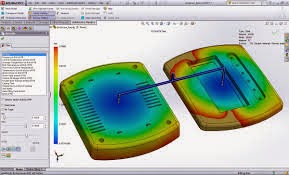Design plastic parts more efficiently and accurately.
Take the complexity out of getting your injection molds right the VERY first time . In a matter of minutes you can test your designs for possible flaws and defects, eliminating rework of expensive molds and reducing costs.
SolidWorks Plastics makes it easy for parts and injection molds. You don’t have to be an expert to easily identify and address companies that design plastic parts or potential defects by making changes to the part or mold design, plastics material, or injection molds to predict and avoid processing parameters, saving resources, time and money.
Manufacturing defects during the earliest stages of design, eliminating costly rework, improving quality, and accelerating time-to- intuitive workflow and design advise to market. Fully integrated with SolidWorks CAD, SolidWorks Plastics works directly on your 3D model, avoiding model conversion issues. You see this intuitive software helps part designers, the impact of design changes right away.
Powerful and fast state of the art meshing covers mold designers and mold makers optimize geometries from thin walled parts to very thick and solid parts. Design for manufacturability without leaving their familiar 3D design experience.
An intuitive interface leads you step by step. Guided analysis, intelligent defaults and automated processes ensure correct setup, even if you rarely use simulation tools.
The SolidWorks Plastics material database contains thousands of commercial plastics and is fully customizable.
- Part designers get rapid feedback on how modifications to wall thickness, gate locations, materials, or geometry can affect the manufacturing of their part.
- while mold designers can quickly optimize multi-cavity and family mold layouts and feed systems including sprues, runners and gates. Analyse and Optimise a range of geometries including thin walled plastic parts.
- The Results Adviser provides practical design advice and troubleshooting tips to help diagnose and solve potential problems. This powerful information gives users tremendous insight into the injection molding process, leading to informed design decisions and better quality products.
While the cost of making changes is low in the early stages of product development, the impact is highest. The sooner you can optimize your plastic parts and injection molds for manufacturability, the better. Design changes in the early stages of product development cost less and have the greatest impact on improving manufacturability.
The cost of change increases substantially further downstream and can lead to significant time-to-market delays. The challenge in plastics part production is determining how your part or mold design impacts manufacturing and how manufacturing will impact your design, and then communicating that information early and often throughout the design to manufacturing process.
SolidWorks Plastics gives you the tools to quickly identify potential problems so you can make changes early in the design process. The most cost effective time to optimize plastic parts for manufacturability is during the initial stages of product design.
Advantages
- Fully embedded in the SolidWorks 3D design environment so you can analyze and modify designs for manufacturability at the same time you optimize for fit, form and function
- Easy to learn, use and does not require extensive analysis or plastics expertise
- Facilitates design team communication: web-based HTML reports make it fast and easy to communicate simulation results and design advice to all members of the design-to-manufacturing team
- Unbalanced filling in family molds can be predicted and avoided with SolidWorks Plastics.
Click the below image for more idea































